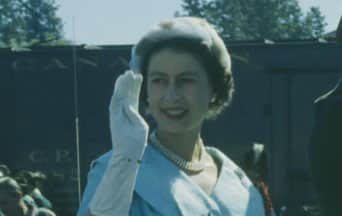
Photo: © BiblioArchives / LibraryArchives, CC BY 2.0
As a young Canadian from a rural town in Northern Ontario, half a world away from Queen Elizabeth II, I can say she profoundly influenced my life.
The Queen represented a whole world of tradition and ceremony that was so crucial for me, growing up in a world that increasingly despises such things. She was an anchor and always upheld the dignity of the monarchy.
While the Queen was by no means perfect and, at times, took the wrong position on a number of moral issues, she nonetheless represented ideals greater than herself. It is these ideals that helped me so much. Without them, my life would not be the same.
A Queen for Our Times
She was a queen for our times. In a world full of uncertainty and agitation, she was a much-needed rock of stability.
In 1947, then-Princess Elizabeth went on air to make a promise to the people of the United Kingdom and Commonwealth. She promised, “my whole life, whether it be short or long, will be devoted to your service.”1 From the day she became queen to the day she died, 70 years later, she never went back on her promise.
Britain’s Monarchy: An Echo of the Middle Ages
The traditions Queen Elizabeth II embodied and upheld were an echo of the Middle Ages, a time when society was completely God-centered.
Spanning nearly 1200 years from the reign of the Saxon King Egbert, Britain’s monarchy is rooted in tradition.
In fact, the splendid coronation ceremony of the British monarchy as we know it today comes from the times of William the Conqueror, who was crowned king in 1066. Thus, the coronation ceremony, which will take place for the new king, Charles III, is nearly 1000 years old!2
 Learn All About the Prophecies of Our Lady of Good Success About Our Times
Learn All About the Prophecies of Our Lady of Good Success About Our Times
During this ancient coronation ceremony, full of Catholic tradition, the monarch is entrusted with the two symbols of royal authority: the orb and the scepter.
The orb has a Cross on top, which represents the authority that Christ the King has over the world. Thus, the monarch, whose authority comes from God, is called to uphold this Christian order.
The other royal symbol is the scepter, which has a Cross on the tip and represents the temporal power of the monarch.3
Looking for the Marvelous
The ceremonies that have taken place throughout the queen’s reign and those following her death are full of marvelous symbols and rituals. We can and should look for and admire these marvelous traditions which are a fruit of Christian civilization.
One of these sublime traditions was a vigil before the Queen’s body lying in rest in St. Giles’ Cathedral in Edinburgh, Scotland.
It is a tradition known as the Vigil of the Princes. During the vigil, the King, Charles III, the Queen’s children, and four members of the Royal Company of Archers stood watch with heads bowed facing outwards while mourners passed by. The scene was a profoundly touching yet solemn moment.
This is why I remember the Queen. I remember all the traditions and ideals she so dutifully represented, and I mourn her passing.
Footnotes
- https://apnews.com/article/queen-elizabeth-ii-remembrance-8013aa054b8d3dc0dbda80ebda2cea41#:~:text=LONDON%20(AP)%20%E2%80%94%20On%20her,be%20devoted%20to%20your%20service.%E2%80%9D
- https://www.worldhistory.org/article/1533/the-coronation-ceremony-of-the-british-monarchy/
- https://thecrownchronicles.co.uk/explanation/symbols-of-monarchy-sovereigns-orb-and-sceptre/

